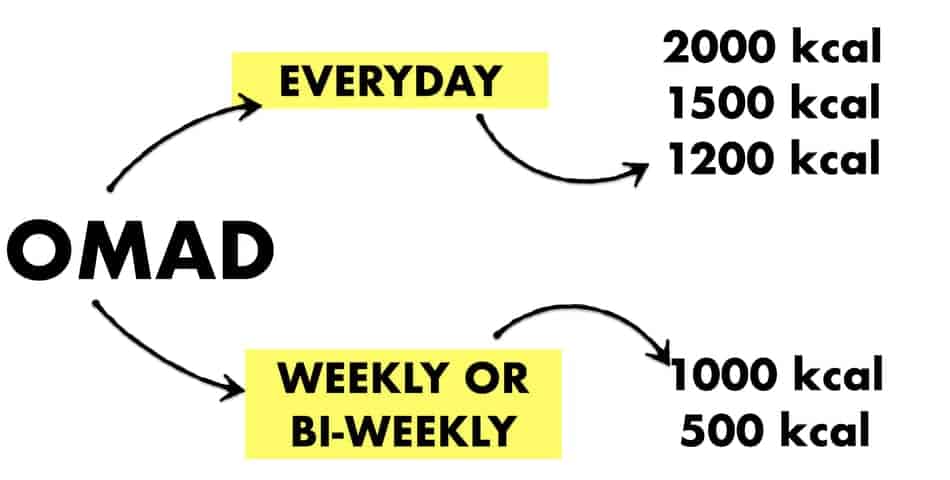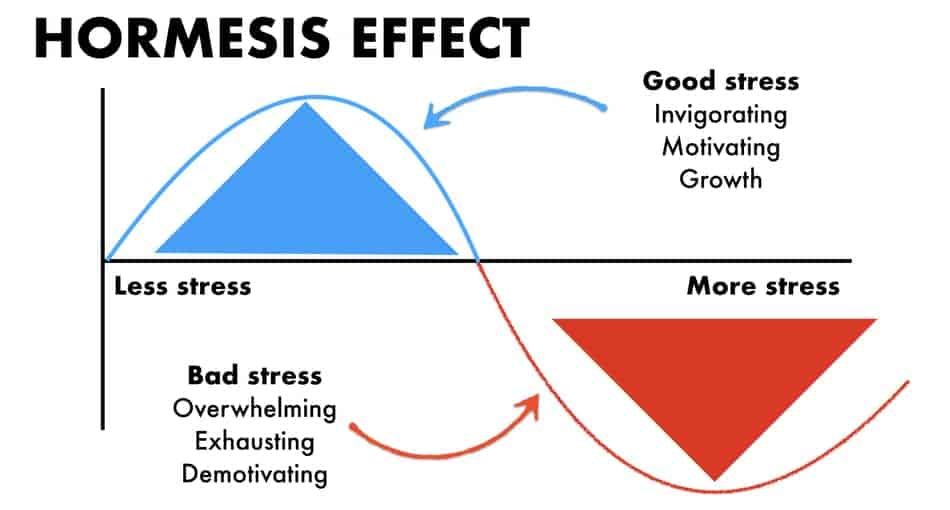
Counting calories is been a proven and time-tested method to give the most accurate results for fat loss. However, when you do OMAD, should you still be counting calories?
In general, you shouldn’t be counting calories on OMAD, as long as you eat high-quality and nutrition-dense foods. Eating one meal a day that consists of protein-rich foods, whole foods, fruits, vegetables, and high-fiber foods will create negative energy, without counting calories.
However, it all depends on how often you do OMAD, and what food you eat.
OMAD and Calorie Counting
Calories do matter on OMAD because eating too many calories moves the body from negative energy balance to a positive energy balance. This stops weight loss and causes weight gain, regardless if you’re eating one meal a day or regular three meals.
How many calories should you eat on the OMAD diet? You should be eating 1,500 – 2,500 calories per day on OMAD. The number of calories will depend on your body weight, physical activity, age, gender, and lean mass. For men, the optimum number of calories is 1,500 – 2,500 per day. For women, the optimum amount of calories a day is 1,400 – 2,000.
Plus, it will also depend on how often you are doing intermittent fasting, how well you can tolerate calorie deficit, what is your weight loss goal, and other lifestyle factors.
For instance, if you’re doing OMAD every day you may consider eating slightly more calories than if you just do it once a week. This will ensure you are in a caloric deficit and have sufficient energy to maintain your lifestyle.
In the graph below you can see I’ve broken down this basic concepts.

People who are doing OMAD every day should have a slightly higher calorie number. Doing OMAD daily is much different than doing OMAD once a week.
For people who do OMAD every day, the calorie intake needs to be higher because all energy is coming from this one meal. If the calorie intake is too low for too long, after several days the body may feel tired and lethargic.
On the other hand, if you’re doing OMAD 1-3 days a week, and on the rest of the days you eat normally, you can easily go ahead and eat fewer calories on your fasting days.
This process is more suitable for people who have set schedules (weekdays and weekends), for people who work shifts (24 hours on, 48 hours off), and for people who just prefer to have a couple of days where they can eat.
In that case, you can easily do OMAD with eating 1,200, 1,000 or even 500 calories per day. But if you want to maintain this low volume of food for long term, its not sustainable.
In the table below you can see a comparison between doing OMAD on 500 – 1000 calories, versus doing OMAD on 1,500 – 2,500 calories.
| Calories on OMAD | PROS | CONS |
|---|---|---|
| 500 – 1000 kcal per day | gives the fastest results works with any food doesn’t require exercise | it’s not for everyone requires strong hunger tolerance crushes the metabolic rate enhance protein breakdown |
| 1500 – 2500 kcal per day | maintains protein synthesis maintains energy is more sustainable | gives slow to moderate results requires whole foods requires protein-rich foods |
OMAD 1000 Calories Per Day
Eating 1000 calories on OMAD is perfect for people who are looking to do intermittent fasting only a few days a week. This amount of calories is way below basal metabolic rate and over time it leads to a slow metabolism.
So if you’re planning to do OMAD for the long haul, see jaw-dropping results, and stay healthy at the same time, 1000 calorie days should be alternated with a regular eating day.
Remember there are infinite ways to do intermittent fasting and OMAD is just one of them. So you don’t have to box yourself.
OMAD 500 Calories Per Day
Having 500 calories on the daily basis doing OMAD is just not enough. Yes, you can stay there for a week or two. But can you do it for 3-6 months? Don’t think so.
Instead, treat that as your fasting day where you just eat one medium-size meal a couple of times a week. So do it but only on specific days. Rest of the week eat as usual.
The reason why 500 calories on OMAD is just not a good idea is that you will feel like crap. So it’s not sustainable. This is not a sprint. It’s more of a marathon. Slow and steady wins the race (source).
Eating Not Enough Calories on OMAD
In general, eating not enough calories on OMAD in the long term slows down the metabolic rate, reduces daily energy expenditure, reduces gastrointestinal motility, and lowers energy levels. This means you can feel weak, tired, lose control and bounce to compulsive eating.
Going too low for too long usually adds more stress, creates unnecessary pressure, and leads to unwanted eating behaviors. You can simply avoid that by eating more calories.
This concept is called the hormesis effect.
The short-term stressor that is infrequent can have a positive effect on the body. That’s how we grow, learn and get better. But chronic and unwanted stress over a long period of time will make us feel progressively worse (source).
For instance, exercising every day for 20-minutes with low intensity can help boost energy, improve focus and sleep. But exercising every day for 4-5 hours with high-intensity will lead to burn-out.

The same with calorie restriction. You can have not enough calories on OMAD for a short period of time, ideally alternating with a normal eating day.
That’s why counting calories on OMAD may feel like a good idea for 2 weeks. But what about 3-6 months?
OMAD Calories Calculator
I wanna show you simple method you can use to calculate how much calories you need on OMAD.
In the table below you can see a simple equation to calculate calories on OMAD based on you activity level. On the left side you have activity level, where on the right side you see multiply column.
| Activity | Multiply |
|---|---|
| Sedentary | 10-12 |
| Moderate (3-4 x per week) | 12-14 |
| Very active (5-7 x per week) | 14-16 |
The calculator works by multiplying your current weight in pounds by the number on the right side. The number has to match your physical activity. Now, going one step further, in the next table I have a chart that breakdown a few examples for a variety of body weights.
All you need to do is know your current body weight and estimate how many days per week you’re exercising. Then follow the table below and you will know exactly how many calories you should be eating on OMAD.
| Body weight | Sedentary | Moderate | Very active |
|---|---|---|---|
| 140 lbs | 1400 – 1600 | 1600 – 1900 | 1900 – 2200 |
| 160 lbs | 1600 – 1900 | 1900 – 2200 | 2200 – 2500 |
| 180 lbs | 1800 – 2100 | 2100 – 2500 | 2500 – 2800 |
| 200 lbs | 2000 – 2400 | 2400 – 2800 | 2800 – 3200 |
| 220 lbs | 2200 – 2600 | 2600 – 3000 | 3000 – 3500 |
| 240 lbs | 2400 – 2800 | 2800 – 3300 | 3300 – 3800 |
| 260 lbs | 2600 – 3100 | 3100 – 3640 | 3600 – 4100 |
| 280 lbs | 2800 – 3300 | 3300 – 3900 | 3900 – 4400 |
| 300 lbs | 3000 – 3600 | 3600 – 4200 | 4200 – 4800 |
Don’t be fooled by the simplicity of this chart. This equation is on point with every single online calculator. It takes into consideration your basal metabolic rate and lean muscle mass.
OMAD vs Calorie Counting (What makes more sense?)
Counting calories has its time and place. It is usually done by people who has a very strategic goal in mind. Competition (physique, bodybuilding), job interview (army, police academy), performance (dancers, acrobatics, gymnasts).
Studies show that counting calories and following the meal plan to the T is the most accurate way to get the results. In contrast, studies also have shown that it’s much better to focus on the actual behaviors rather than counting calories for the long-term results (source).
Some people love numbers and they love to solve problems. But for regular people like you and me, counting calories comes with the cost. Here I wanna show you the pros and cons of doing OMAD with intuitive eating versus counting calories.
| Method | PROS | CONS |
|---|---|---|
| OMAD with counting calories | it’s more accurate gives better results allow reaching specific goals | requires consistent calculations looks at food as good or bad (based on calorie numbers) can take away the joy of eating can create extra stress |
| OMAD without calorie counting | require less work helps to enjoy the food reduces stress is more sustainable | it’s less accurate can lead to mindless eating |
As you can see, there is no better or worse option. In the short term, doing OMAD with counting calories may seem like a way to go. But in the long-term, this can create more pressure and rules to follow.
Do You Have To Count Calories On OMAD?
In general, if you don’t want to count calories on OMAD you don’t have to. Eating just one meal a day that is full of proteins, high-satiety carbs and fresh fruits will be enough to get to a calorie deficit. However, if you do want to count calories, you can do so for better results.
Counting calories on OMAD allows for more precise measurements and more precise overall intake, to reach more specific goals. If your personal goal is to get down to a single-digit fat percentage or to lose a substantial amount of weight, then you can use a calorie calculator.
Some people enjoy counting calories daily. They love to keep the spreadsheet and measure their food intake. But for the majority of people, counting calories adds more rules and unnecessary stress.
How many calories should I eat on OMAD to lose weight? Generally, you should be eating around 1000 – 1500 calories on OMAD to lose weight, depending on your basal metabolic rate. Basal metabolic rate is the total energy cost for your basic functions like breathing, blood flow, and cognitive functions.
OMAD without Calorie Counting
Eating only one meal a day in itself is already a big commitment for many people.
You can do OMAD without counting calories, as long as you focus on whole foods that are minimally processed and nutrient-dense. Eating whole foods proves enough fiber and protein that support satiety and lower the appetite, where processed foods increase the hunger.
Remember that when you’re doing OMAD without counting calories, it doesn’t mean you can eat an unlimited amount of food. You can still create a calorie surplus if you eat just one meal a day.
I personally believe that not counting calories on OMAD is healthy because it focuses on behaviors rather than on outcomes. Counting calories and numerically oriented details creates anxiety. Focusing on behaviors like stress reduction, physical activity, and self-awareness leads to long-term results.
Conclusion
Initial counting calories on OMAD can be beneficial but over the long-time, it can create more anxiety and stress. That’s why it’s better to find a way to reduce stress, with will help with the sustainability of the process. Counting calories makes us focus on outcomes that are sometimes out of the initial reach.
